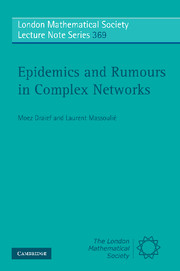Book contents
- Frontmatter
- Contents
- Introduction
- PART I SHAPELESS NETWORKS
- 1 Galton–Watson branching processes
- 2 Reed–Frost epidemics and Erdős–Rényi random graphs
- 3 Connectivity and Poisson approximation
- 4 Diameter of Erdős–Rényi graphs
- 5 From microscopic to macroscopic dynamics
- PART II STRUCTURED NETWORKS
- References
- Index
1 - Galton–Watson branching processes
Published online by Cambridge University Press: 25 January 2011
- Frontmatter
- Contents
- Introduction
- PART I SHAPELESS NETWORKS
- 1 Galton–Watson branching processes
- 2 Reed–Frost epidemics and Erdős–Rényi random graphs
- 3 Connectivity and Poisson approximation
- 4 Diameter of Erdős–Rényi graphs
- 5 From microscopic to macroscopic dynamics
- PART II STRUCTURED NETWORKS
- References
- Index
Summary
Introduction
The branching process model was introduced by Sir Francis Galton in 1873 to represent the genealogical descendance of individuals. More generally it provides a versatile model for the growth of a population of reproducing individuals in the absence of external limiting factors. It is an adequate starting point when studying epidemics since, as we shall see in Chapter 2, it describes accurately the early stages of an epidemic outbreak. In addition, our treatment of so-called dual branching processes paves the way for the analysis of the supercritical phase in Chapter 2. Finally, the present chapter gives an opportunity to introduce large deviations inequalities (and notably the celebrated Chernoff bound), which is instrumental throughout the book.
A Galton–Watson branching process can be represented by a tree in which each node represents an individual, and is linked to its parent as well as its children. The “root” of the tree corresponds to the “ancestor” of the whole population. An example of such a tree is depicted in Figure 1.1.
In the following we consider three distinct ways of exploring the so-called Galton–Watson tree, each well suited to establishing specific properties.
In the depth-first view, we start by exploring one child in the first generation, then explore using the same method recursively the subtree of its descendants, before we move to the next child of the first generation.
- Type
- Chapter
- Information
- Epidemics and Rumours in Complex Networks , pp. 7 - 18Publisher: Cambridge University PressPrint publication year: 2009

